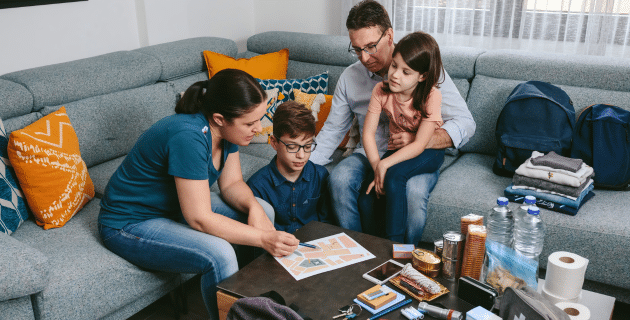An earthquake, flood, fire, or severe storm can strike at any time — and you and your family may not be together when it does.
How will you find each other if separated? What about household members who have medical conditions? And what if your cell phones or networks are out of power?
Crafting an emergency plan before a disaster hits gives you time to discuss your family’s needs and circumstances, review possible scenarios, and decide on the best options together. Schedule a time when the whole family can participate. You may need one or two additional meetings to finalize all the details.
Here’s what you’ll need to cover:
1. Make A Plan of Action
Smart planning entails talking through a number of situations and “what-ifs.” Start by brainstorming around the following (and remember that coronavirus may affect some answers).
- What natural disasters are we most likely to experience?
- How will we receive emergency alerts and warnings?
- What are the escape or evacuation routes from our house?
- What is our shelter plan?
2. If Your Family is Separated
Re-opening across the country means parents may be going back to work and kids back to school. Are there other locations, such as after-school programs, childcare, gyms or volunteer sites that family members regularly attend? Consider those when answering the following:
- If separated during an emergency, where should we meet near our home?
- If meeting near home is impossible for some or all family members, what’s our meeting place?
- If we are separated, who is our emergency contact outside of our immediate area?
3. Specific Needs of Family Members
Remember to tailor your plan to address any particular needs of/by family members, such as:
- Medical needs including prescriptions and equipment
- Dietary needs
- Medical conditions, disabilities or functional needs, especially those requiring devices and equipment
- Language barriers or limitations
- Ages of all household members, including school-aged children
- Pets or service animals
- Religious and cultural considerations
5. Fill Out the Plan
After discussing the above, it’s time to get it all down on paper. Be sure to capture the following as well.
- All the contact information for each household member.
- Who’s responsible for what during the disaster? Tasks might include things like retrieving the disaster kit, evacuating pets, and fielding disaster updates and alerts.
- Create a personal network of friends, family or neighbors for things you might need help with.
- Make sure you have one or more out-of-town contacts for emergencies.
- Numbers for important contacts such as utilities, financial companies, childcare and caregivers, veterinarians, and insurance companies.
6. Share & Practice
During an emergency, cellular networks and wi-fi may be unreliable, and computers and phones may be lost or out of power. In these cases, having a paper copy of your family disaster plan can save precious time, minimize stress and prevent unnecessary emergencies. So, make sure each family member has a copy and carries it with them in a purse, backpack or work bag (here’s a template plan that fits in your wallet). Have regular family meetings to review the plan and practice. Finally, do a thorough review every 6 months or so, to update information or responsibilities.
7. Resources
Check out these resources to get your plan disaster-ready.
- Disaster plan templates here (American Red Cross) and here (FEMA).
- Stay current on coronavirus updates at this CDC page.
- Articles on disaster preparation checklist, disaster prep for your pets, emergency kit essentials, and tips to revise your plan in the age of coronavirus.
The perfect time to make a plan is right now. Getting all your family members on board and in the know sooner rather than later will ensure that you’re all ready when you need to be.
This article is furnished by California Casualty, providing auto and home insurance to educators, law enforcement officers, firefighters, and nurses. Get a quote at 1.866.704.8614 or www.calcas.com.
- Graduation – When to Remove Your Child from Your Auto Policy - May 18, 2023
- How to Prevent Catalytic Converter Theft - May 17, 2023
- How Much Does Home Insurance Cost? - May 17, 2023

